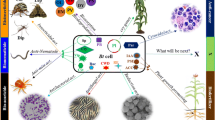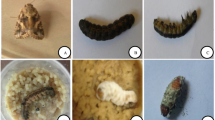Abstract
The potato/tomato psyllid, Bactericera cockerelli (Šulc) is an economically important crop pest that not only causes damage through its feeding but also transmits the bacterium, “Candidatus Liberibacter solanacearum” (CLs), which causes zebra chip disease in potato. There is some information about the phenotypic effects of phytopathogenic bacteria on their insect vectors; however, there are no published reports of the molecular mechanisms underlying phytopathogenic bacteria–insect vector interaction. In order to investigate the effects of CLs infection on B. cockerelli, transcriptomic analyses of CLs-infected and uninfected adult psyllids that were reared on potato were performed. De novo assembly of cDNA sequences generated 136,518 and 109,983 contigs for infected and uninfected insect libraries with an average contig length of 514 bp. BlastX analysis against the NCBI-nr database revealed that 33.33 % had significant matches. Gene ontology data illustrated that the majority of the expressed psyllid genes are involved in metabolic process, biological regulation, binding and catalytic activity. The psyllid transcriptome had an abundance of genes such as vitellogenin, heat shock protein, ejaculatory bulb-specific protein, ferritin, and cytochrome oxidase. Notably absent in the psyllid transcriptome were innate immunity genes induced in response to Gram-negative bacteria (IMD pathway). Several functionally diverse contigs related to symbiotic bacteria including the primary endosymbiont Carsonella ruddii, Wolbachia, and CLs in the psyllid transcriptome were identified. A total of 247 contigs showed differential expression in response to CLs infection including immune and stress-related genes and vitellogenins. Expression analyses of selected psyllid genes were performed on psyllids that were exclusively reared on potato (host of the insects used for RNAseq) and psyllids exclusively reared on tomato (alternative host of psyllids). These genes showed similar expression patterns irrespective of the host plant on which the psyllids were reared, which suggests that host–plant association may not modulate expression of these genes. Our findings suggest that the impact of CLs on psyllid transcriptome was to a large extent on genes involved in metabolic processes and to a small extent on immune and stress response genes. This study is the first description of transcriptomic changes in an insect vector in response to infection with a naturally occurring bacterial plant pathogen. Data from this study provide new sequence and gene expression resources for functional genomics of potato psyllids.





Similar content being viewed by others
References
Abad JA, Bandla M, French-Monar RD, Liefting LW, Clover GRG (2009) First report of the detection of ‘Candidatus Liberibacter’ species in zebra chip disease-infected potato plants in the United States. Plant Dis 93(1):108
Ahmed AM, Maingon R, Romans P, Hurd H (2001) Effects of malaria infection on vitellogenesis in Anopheles gambiae during two gonotrophic cycles. Insect Mol Biol 10(4):347–356
Baumann P (2005) Biology bacteriocyte-associated endosymbionts of plant sap-sucking insects. Annu Rev Microbiol 59:155–189
Baumann P, Baumann L, Clark MA (1996) Levels of Buchnera aphidicola Chaperonin GroEL during growth of the aphid Schizaphis graminum. Curr Microbiol 32(5):279–285
Baumann P, Moran N, Baumann L (2006) Bacteriocyte-associated endosymbionts of insects. In: Dworkin M, Falkow S, Rosenberg E, Schleifer K-H, Stackebrandt E (eds) The prokaryotes. Springer, New York, pp 403–438
Bidla G, Dushay MS, Theopold U (2007) Crystal cell rupture after injury in Drosophila requires the JNK pathway, small GTPases and the TNF homolog Eiger. J Cell Sci 120:1209–1215
Carter W (1939) Injuries to plants caused by insect toxins. Botan Rev 5:273–326
Cranshaw WS (2001) Diseases caused by insect toxin: psyllid yellows. In: Stevenson WR, Loria R, Franc GD, Weingartner PD (eds) Compendium of potato diseases, 2nd edn. APS, St. Paul, pp 73–74
Crosslin JM, Bester G (2009) First report of ‘Candidatus Liberibacter psyllaurous’ in Zebra Chip symptomatic potatoes from California. Plant Dis 93(5):551
Crosslin JM, Munyaneza JE, Brown JK, Liefting LW (2010) Potato zebra chip disease: a phytopathological tale. Plant Health Progr. doi:10.1094/PHP-2010-0317-1001-RV
Daborn PJ, Waterfield N, Blight MA, Ffrench-Constant RH (2001) Measuring virulence factor expression by the pathogenic bacterium Photorhabdus luminescens in culture and during insect infection. J Bacteriol 183:5834–5839
De Gregorio E, Spellman PT, Rubin GM, Lemaitre B (2001) Genome-wide analysis of the Drosophila immune response by using oligonucleotide microarrays. Proc Natl Acad Sci 98:12590–12598
Gerardo N, Altincicek B, Anselme C, Atamian H, Barribeau S, de Vos M, Duncan E, Evans J, Gabaldon T, Ghanim M, Heddi A, Kaloshian I, Latorre A, Moya A, Nakabachi A, Parker B, Perez-Brocal V, Pignatelli M, Rahbe Y, Ramsey J, Spragg C, Tamames J, Tamarit D, Tamborindeguy C, Vincent-Monegat C, Vilcinskas A (2010) Immunity and other defenses in pea aphids Acyrthosiphon pisum. Genome Biol 11(2):R21
Govind S (2008) Innate immunity in Drosophila: pathogens and pathways. Insect Sci 15(1):29–43
Hail D, Hunter WB, Dowd SE, Bextine B (2010) Expressed sequence tag (EST) survey of life stages of the potato psyllid, Bactericera cockerelli, using 454 pyrosequencing. Southwest Entomol 35(3):463–466
Hansen AK, Trumble JT, Stouthamer R, Paine TD (2008) A new Huanglongbing Species, “Candidatus Liberibacter psyllaurous,” found to infect tomato and potato, is vectored by the psyllid Bactericera cockerelli (Sulc). Appl Environ Microbiol 74(18):5862–5865
Hogenhout SA, van der Wilk F, Verbeek M, Goldbach RW, van den Heuvel JFJM (1998) Potato leafroll virus binds to the equatorial domain of the aphid endosymbiotic GroEL homolog. J Virol 72(1):358–365
Hogenhout S, el Ammar D, Whitfield A, Redinbaugh M (2008) Insect vector interactions with persistently transmitted viruses. Annu Rev Phytopathol 46:327–359
Hunter WB, Dowd SE, Katsar CS, Shatters RGJ, McKenzie CL, Hall DG (2009) Psyllid biology: expressed genes in adult Asian citrus psyllids Diaphorina citri Kuwayama. Open Entomol J 3(18):18–29
Hurd H (2003) Manipulation of medically important insect vectors by their parasites. Annu Rev Entomol 48:141–161
Liefting LW, Perez-Egusquiza ZC, Clover GR, Anderson JAD (2008) A new ‘Candidatus Liberibacter’ species in Solanum tuberosum in New Zealand. Plant Dis 92:1474
Liefting LW, Southerland PW, Ward LI, Paice KL, Weir BS, Clover GRG (2009) A new “Candidatus Liberibacter” species associated with diseases of solanaceous crops. Plant Dis 92:208–214
Liu D, Trumble JT, Stouthamer R (2006) Genetic differentiation between eastern populations and recent introductions of potato psyllid (Bactericera cockerelli) into western North America. Entomol Exp Appl 118(3):177–183
Livak KJ, Schmittgen TD (2001) Analysis of relative gene expression data using real-time quantitative PCR and the 2 − ΔΔCT method. Methods 25(4):402–408
MAFBNZ (2008) http://www.biosecurity.govt.nz/pestdiseases/plants/potato-tomato-psyllid.htm (accessed 18 September 2008)
Morin S, Ghanim M, Zeidan M, Czosnek H, Verbeek M, van den Heuvel JFJM (1999) A GroEL homologue from endosymbiotic bacteria of the whitefly Bemisia tabaci is implicated in the circulative transmission of tomato yellow leaf curl virus. Virology 256:75–84
Mortazavi A, Williams BA, McCue K, Schaeffer L, Wold B (2008) Mapping and quantifying mammalian transcriptomes by RNA-Seq. Nat Meth 5(7):621–628
Munyaneza JE, Crosslin JM, Upton JE (2007) Association of Bactericera cockerelli (Homoptera: Psyllidae) with “zebra chip,” a new potato disease in southwestern United States and Mexico. J Econ Entomol 100(3):656–663
Nachappa P, Levy J, Pierson E, Tamborindeguy C (2011) Diversity of endosymbionts in the potato psyllid, Bactericera cockerelli (Hemiptera: Triozidae), vector of zebra chip disease of potato. Curr Microbiol 62:1510–1520
Nachappa P, Shapiro A, Tamborindeguy C (2012) Effect of “Candidatus Liberibacter solanacearum” on fitness of its vector, Bactericera cockerelli (Hemiptera: Triozidae) on tomato. Phytopathology 102(1):41–46
Oliver K, Degnan PH, Burke GR, Moran NA (2010) Facultative symbionts in aphids and the horizontal transfer of ecologically important traits. Annu Rev Entomol 55:247–266
Pack HJ (1930) Potato psyllid. Utah Agric Expt Stn Bull 216:21
Peng X, Zha W, He R, Lu T, Zhu L, Han B, He G (2011) Pyrosequencing the midgut transcriptome of the brown planthopper, Nilaparvata lugens. Insect Mol Biol 20(6):745–762
Pletsch DJ (1947) The potato psyllid Paratrioza cockerelli (Sulc), its biology and control. Montana Agric Exp Stn Bull 446:95
Purcell AH (1982a) Evolution of the insect vector relationship. In: Mount MS, Lacey GH (eds) Phytopathogenic prokaryotes. Academic Press, New York, pp 121–156
Purcell AH (1982b) Insect vector relationships with procaryotic plant pathogens. Annu Rev Phytopathol 20:397–417
Raikhel AS (1986) Role of lysosomes in regulating of vitellogenin secretion in the mosquito fat body. J Insect Physiol 32:597–604
Raikhel A, Dhadialla T (1981) Accumulation of yolk proteins in insect oocytes. Ann Rev Entomol 37:217–251
Rono MK, Whitten MMA, Oulad-Abdelghani M, Levashina EA, Marois E (2010) The major yolk protein vitellogenin interferes with the anti-Plasmodium response in the malaria mosquito Anopheles gambiae. PLoS Biol 8(7):e1000434
Ruijter J, Ramakers C, Hoogaars W, Karlen Y, Bakker O, Van Den Hoff M, Moorman A (2009) Amplification efficiency: linking baseline and bias in the analysis of quantitative PCR data. Nucleic Acids Res 37(6):e45
Secor GA, Rivera-Varas VV (2004) Emerging diseases of cultivated potato and their impact on Latin America. Revista Latinoamericana de la Papa (Suplemento) 1:1–8
Shi X (2006) Vitellogenin is a novel player in defense reactions. Fish Shellfish Immunol 20(5):769
Stout MJ, Thaler JS, Thomma BPHJ (2006) Plant-mediated interactions between pathogenic microorganisms and herbivorous arthropods. Annu Rev Entomol 51(1):663–689
Thao ML, Clark MA, Baumann L, Brennan EB, Moran NA, Baumann P (2000a) Secondary endosymbionts of psyllids have been acquired multiple times. Curr Microbiol 41(4):300–304
Thao ML, Moran NA, Abbot P, Brennan EB, Burckhardt DH, Baumann P (2000b) Cospeciation of psyllids and their primary prokaryotic endosymbionts. Appl Environ Microbiol 66(7):2898–2905
Trapnell C, Williams BA, Pertea G, Mortazavi A, Kwan G, van Baren MJ, Salzberg SL, Wold BJ, Pachter L (2010) Transcript assembly and quantification by RNA-Seq reveals unannotated transcripts and isoform switching during cell differentiation. Nat Biotech 28(5):511–515
Wahli W, Dawid I, Ryffel G, Weber R (1981) Vitellogenesis and the vitellogenin gene family. Science 212:298–304
Wallis RL (1955) Ecological studies on the potato psyllid as a pest of potatoes, vol 1107. Tech Bull, US Dep Agric, pp 1–24
Wu LP, Choe KM, Lu Y, Anderson KV (2001) Drosophila immunity: genes on the third chromosome required for the response to bacterial infection. Genetics 159:189–199
Xue J, Bao Y–Y, Li B-l, Cheng Y-B, Peng Z-Y, Liu H, Xu H-J, Zhu Z-R, Lou Y-G, Cheng J-A, Zhang C-X (2010) Transcriptome analysis of the brown planthopper Nilaparvata lugens. PLoS One 5(12):e14233
Zhang F, Guo H, Zheng H, Zhou T, Zhou Y, Wang S, Fang R, Qian W, Chen X (2010) Massively parallel pyrosequencing-based transcriptome analyses of small brown planthopper (Laodelphax striatellus), a vector insect transmitting rice stripe virus (RSV). BMC Genomics 11(1):1–13
Acknowledgments
We thank Drs. Rush, Henne and Munyaneza for supplying psyllid stocks that were used to establish the colonies used in this study.
Author information
Authors and Affiliations
Corresponding author
Additional information
Communicated by A. Hirsch.
P. Nachappa and J. Levy have contributed equally to this paper.
Rights and permissions
About this article
Cite this article
Nachappa, P., Levy, J. & Tamborindeguy, C. Transcriptome analyses of Bactericera cockerelli adults in response to “Candidatus Liberibacter solanacearum” infection. Mol Genet Genomics 287, 803–817 (2012). https://doi.org/10.1007/s00438-012-0713-9
Received:
Accepted:
Published:
Issue Date:
DOI: https://doi.org/10.1007/s00438-012-0713-9




